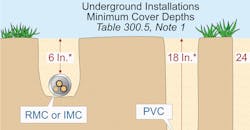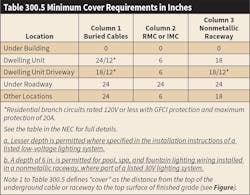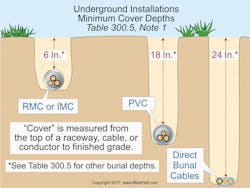Stumped by the Code? Requirements for Underground Cables and Raceways
All questions and answers are based on the 2017 NEC.
Underlined text indicates a change in the rules for the 2017 NEC.
Q. What does the Code require for underground cables and raceways?
A. As outlined in Sec. 300.5(A), when cables or raceways are installed underground, they must have a minimum “cover” in accordance with Table 300.5. Cover is defined in Note 1 at the bottom of the Table.
The cover requirements contained in Sec. 300.5 don’t apply to signaling, communications, and other power-limited wiring systems:
- Class 2 and 3 Circuits (Sec. 725.3)
- Communications Cables and Raceways (Sec. 90.3)
- Coaxial Cable (Sec. 90.3)
- Fire Alarm Circuits (Sec. 760.3)
- Optical Fiber Cables and Raceways (Sec. 770.3)
As outlined in Sec. 300.5(B), the interior of enclosures or raceways installed in an underground installation are considered to be a wet location. Cables and insulated conductors installed in underground enclosures or raceways must comply with Sec. 310.10(C) requirements for the insulation of conductors and cables.
The definition of a “wet location,” as contained in Art. 100, includes installations underground, in concrete slabs in direct contact with the earth, locations subject to saturation with water, and unprotected locations exposed to weather. If raceways are installed in wet locations above grade, the interior of these raceways is also considered to be a wet location [300.9].
Section 300.5(C) notes that cables and conductors installed under a building must be installed within a raceway that extends past the outside walls of the building. However, Exception No. 2 states that Type MC cable listed for direct burial is permitted under a building without installation within a raceway [330.10(A)(5)].
Section 300.5(D) says direct-buried conductors and cables such as Types MC, UF, and USE installed underground must be protected from damage in accordance with (1) through (4).
(1) Emerging from grade. Direct-buried cables or conductors that emerge from grade must be installed in an enclosure or raceway to protect against physical damage. Protection isn’t required to extend more than 18 in. below grade, and protection above ground must extend to a height of not less than 8 ft.
(2) Conductors entering buildings. Underground conductors and cables that enter a building must be protected to the point of entrance.
(3) Service conductors. Underground service conductors must have their location identified by a warning ribbon placed in the trench at least 12 in. above the underground conductor installation.
(4) Raceway damage. Where a raceway is subject to physical damage, the conductors must be installed in EMT, RMC, IMC, RTRC‑XW, or Schedule 80 PVC conduit.
Section 300.5(E) notes that direct-buried conductors or cables can be spliced or tapped underground without a splice box [300.15(G)], if the splice or tap is made in accordance with Sec. 110.14(B).
As outlined in Sec. 300.5(F), backfill material for underground wiring must not damage underground raceways, cables, or conductors. Large rocks, chunks of concrete, steel rods, mesh, and other sharp‑edged objects aren’t permitted to be used for backfill material, because they can damage the underground conductors, cables, or raceways.
Section 300.5(G) covers raceways seals. If moisture could contact energized live parts from an underground raceway, including spare raceways, a seal identified for use with the cable or conductor insulation must be installed at either or both ends of the raceway [225.27 and 230.8]. This is a common problem for equipment located downhill from the supply, or in underground equipment rooms. See Sec. 230.8 for service raceway seals and Sec. 300.7(A) for different temperature area seals.
Informational Note: Hazardous explosive gases or vapors make it necessary to seal underground raceways that enter the building in accordance with Sec. 501.15. It isn’t the intent of this Informational Note to imply that sealing fittings of the types required in hazardous locations be installed in unclassified locations, except as required in Chapter 5. This also doesn’t imply that the sealing material provides a watertight seal, but only that it prevents moisture from entering the raceways.
As outlined in Sec. 300.5(H), raceways that terminate underground must have a bushing or fitting at the end of the raceway to protect emerging cables or conductors.
Section 300.5(I) focuses on the grouping of conductors. Underground conductors of the same circuit, including the equipment grounding conductor (EGC), must be inside the same raceway, or in close proximity to each other in the same trench [see 300.3(B)].
Exception No. 1: Conductors can be installed in parallel in raceways, multiconductor cables, or direct‑buried single‑conductor cables. Each raceway or multiconductor cable must contain all conductors of the same circuit, including the equipment grounding conductor. Each direct‑buried single-conductor cable must be located in close proximity in the trench to the other single-conductor cables in the same parallel set of conductors, including equipment grounding conductors.
Exception No. 2: Parallel circuit conductors installed in accordance with Sec. 310.10(H) of the same phase or neutral can be installed in underground PVC conduits, if inductive heating at raceway terminations is reduced by the use of aluminum locknuts and cutting a slot between the individual holes through which the conductors pass as required by Sec. 300.20(B).
Note: Installing ungrounded and neutral conductors in different PVC conduits makes it easier to terminate larger parallel sets of conductors, but it will result in higher levels of electromagnetic fields (EMF).
As outlined in Sec. 300.5(J), direct-buried conductors, cables, or raceways that are subject to movement by settlement or frost must be arranged to prevent damage to conductors or equipment connected to the wiring.
Informational Note: “S” loops in underground direct burial cables and conductors, raceway expansion fittings, and flexible connections to equipment can serve this purpose.
Section 300.5(K) covers directional boring. Cables or raceways installed using directional boring equipment must be approved by the authority having jurisdiction (AHJ) for this purpose.
- Directional boring technology uses a directional drill, which is steered continuously from point “A” to point “B.” When the drill head comes out of the earth at point “B,” it’s replaced with a back-reamer and the duct or raceway being installed is attached to it. The size of the boring rig (hp, torque, and pull-back power) comes into play, along with the types of soil, in determining the type of raceways required. For telecommunications work, multiple poly innerducts are pulled in at one time. At major crossings, such as expressways, railroads, or rivers, outerduct may be installed to create a permanent sleeve for the innerducts.
- “Innerduct” and “outerduct” are terms usually associated with optical fiber cable installations, while “unit duct” comes with factory-installed conductors. Galvanized rigid metal conduit, Schedule 40 and Schedule 80 PVC, HDPE conduit, and nonmetallic underground conduit with conductors (NUCC) are common wiring methods used with directional boring installations.
About the Author

Mike Holt
Mike Holt is the owner of Mike Holt Enterprises (www.MikeHolt.com), one of the largest electrical publishers in the United States. He earned a master's degree in the Business Administration Program (MBA) from the University of Miami. He earned his reputation as a National Electrical Code (NEC) expert by working his way up through the electrical trade. Formally a construction editor for two different trade publications, Mike started his career as an apprentice electrician and eventually became a master electrician, an electrical inspector, a contractor, and an educator. Mike has taught more than 1,000 classes on 30 different electrical-related subjects — ranging from alarm installations to exam preparation and voltage drop calculations. He continues to produce seminars, videos, books, and online training for the trade as well as contribute monthly Code content to EC&M magazine.



